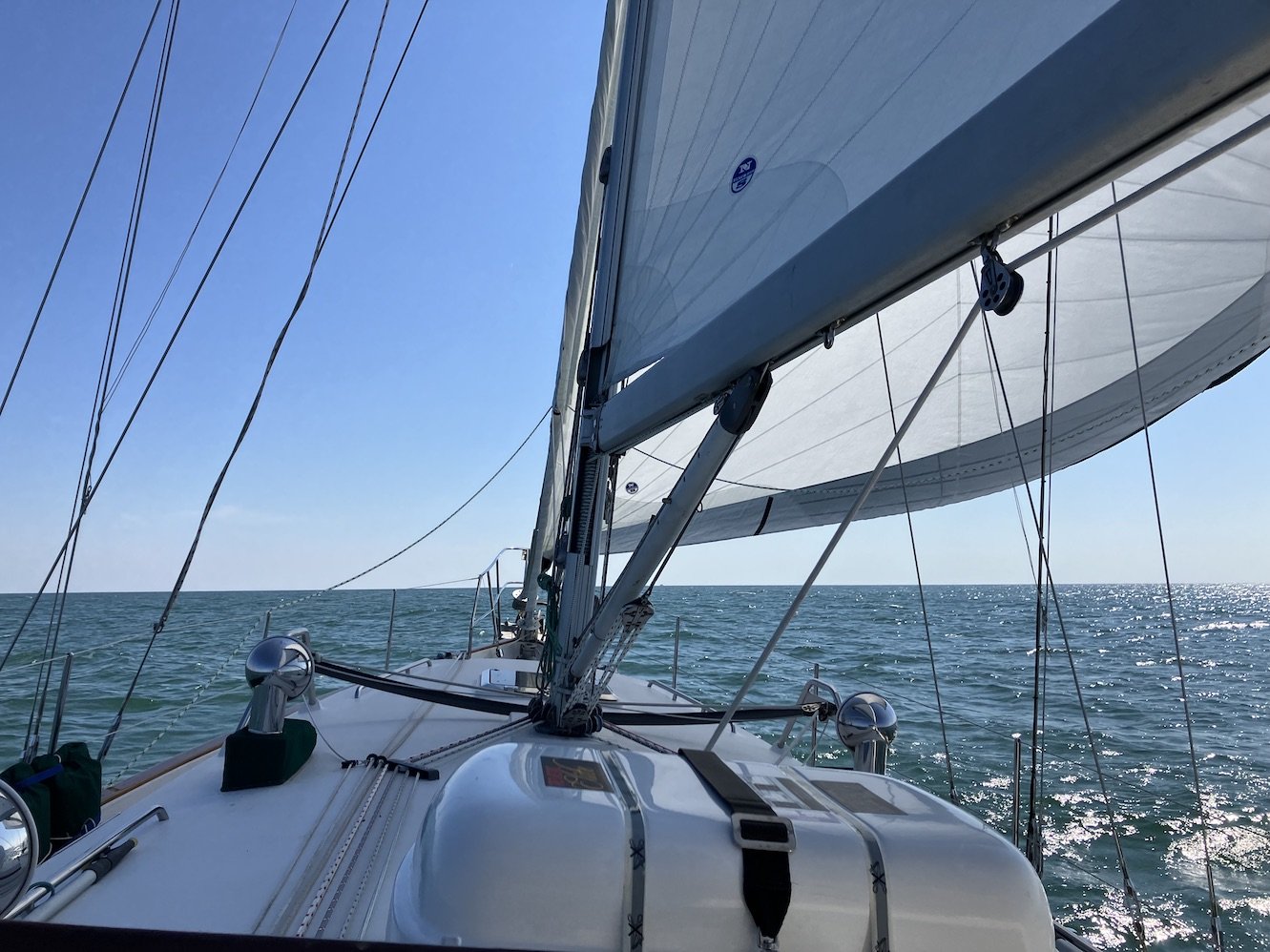When Things Go Better Than Planned
Our last blog described when things go wrong. But sometimes things go better than planned! Two in fact! We had a successful overnight passage on Days 8-9 and we had an awesome journey through the NY Harbor and the East River on Day 10! (check out our Photo Gallery for additional photos of both passages).
Sunrise in Lewes, with power cat that would later pass us on the ocean.
We had never been north of Cape May NJ on Belle Bateau until this journey, but we know several sailing friends who have done this passage many times. Consulting them helped relieve some of our anxiety on the morning of Day 8 as we left Lewes to head 136 nautical miles north to Sandy Hook NJ, tucked inland just south of New York City.
Passing Wildwood NJ to our west (port side) as we headed north
We still felt apprehensive, but knew that we were prepared for this passage, especially with favorable weather conditions. We had west winds early on, which shifted more southerly that afternoon, enabling us to purely sail for more than ten hours. We experienced “fair winds and following seas” as the ocean swells gently raised our stern. Belle Bateau occasionally surfed down the waves as we paralleled the Jersey shore from three or more miles away.
Surfing the waves
Visibility was good, unlike the week before when the Canadian wildfires enveloped the east coast. As night fell, city lights provided illumination that greatly improved our ability to see to the west of us.
Making better time than expected, averaging 7 knots with single reefed genoa and full main.
Fairly early in our passage, we realized we were sailing much faster than anticipated, 7 knots. However, we also expected the winds to die down later. As the afternoon wore on, we realized that we needed to slow Belle Bateau if we wanted to arrive Sandy Hook in daylight rather than 3 am in the morning. By then, we had already furled the main and only had the genoa flying. So, we double-reefed, then triple-reefed, and then quadruple-reefed the headsail, and were still making 4.5 knots with a tiny headsail! Wow! It’s not typical for us to have to slow our boat!
Captain D at the helm
Eventually, as evening approached, the winds dropped and we decided to furl in the jib and fly half the mainsail to steady the boat (and give it some visibility in the dark) while propelling BB with just the engine at low RPMs. Not having to manage the sails gave us one less thing to worry about as night settled in.
Captain C enjoying sunset over the Atlantic Ocean, after eating chicken/rice dinner prepared the day before and easily warmed in our microwave
We had been operating 2.5-hour shift watches all day, since neither of us had slept well the night before due to a lumpy anchorage. The offwatch mate slept at the base of the companionway on an improvised berth, for quick access to the cockpit if needed. We had dimmed all the instruments and charts as low as possible, and used red filtered lights below to assist nighttime visibility. Each of us had headlamps with red as the chosen setting.
Offwatch berth with quick access to cockpit
We had very little boat traffic all day, continuing through the night. At the helm, we had radar on and could compare with our charts and AIS, which helped us monitor ships. We became accustomed to the ones that appeared to be close but were in fact anchored 12-20 miles away. We also got better at deciphering lights that were stars and aircraft. There were some occasional confusing moments, trying to understand lights and reflections on the water. But with each shift change, we found our own rhythms and as Cheryl likes to say “we became one with the sea.”
This photo shows the instruments dimmed as low as possible. We used D’s iPad with Navionics (upper right) to show our intended route, which makes it easy to follow (and offers redundancy). Our chart plotter (lower right) has a split screen, with charts on the left and radar on the right. The red square (middle top) is not an instrument but is actually our red-lit companionway, offering a peek down below.
Then before we knew it, the skies were brightening an hour before sunrise, and we could see the Manhattan skyline much more clearly. We turned easily into Sandy Hook and anchored in Atlantic Highlands for better protection from southerly winds.
Manhattan emerging before sunrise.
We had done it! Our first overnight passage together, and Belle Bateau’s first overnight journey with the two of us!








